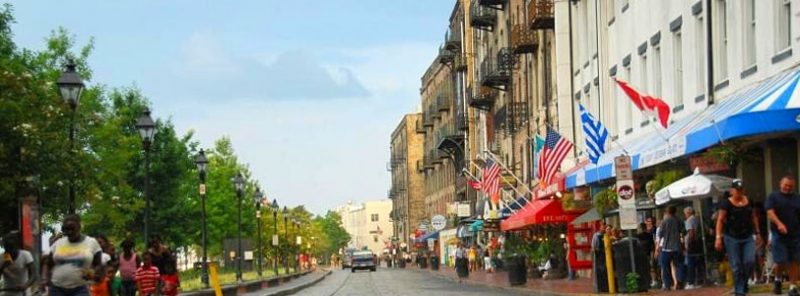Whether you are new to Savannah or just visiting, Historic River Street is a must-see! Beautiful shops dot the riverfront, street performers provide live entertainment, and the aroma of fresh-baked pralines fills the air!
Whether you’re a local, a tourist, or something in between, nothing quite compares to a leisurely walk down River Street.

Walk into the River House and take a swig of its signature Chatham Artillery Punch. Or charm your significant other with a hand-crafted bamboo rose. Or buy some beads and drink a green beer with the throng on St. Patrick’s Day. Be sure to wave to the Old Towne Trolley guide leading a group of eager, fan-waving tourists in a lesson on the finer points of Savannah’s storied history. And wave to Paula Deen during the holiday parade while you’re at it. Or you can buy a Christmas ornament in April, a leather biker jacket in June, or a conch fritter and a mojito in August. Or just take a seat on one of the street’s many benches for a leisurely but vigorous episode of people-watching. Just make you’ve paid for enough parking.
Yet for all its seductive Southern charm, River Street has been a chameleon over the years. Oglethorpe landed at the barren bluff in 1733 with dreams of establishing England’s 13th colony. By the early 1800s, his dreams became a reality as Savannah’s waterfront quickly became the nexus of the East Coast’s bustling cotton industry. By 1818, though, the cotton industry collapsed and a yellow fever outbreak occurred, nearly eliminating what was once a thriving port.
In 1864, General William T. Sherman captured Savannah and presented the city as a Christmas present to President Lincoln. Thoroughly charmed by Savannah and its genteel denizens, Sherman spared River Street the flames that decimated Atlanta during his epic March to the Sea. Soon thereafter, forward-thinking “urban planners” carved a dirt road along the water to ease traffic and facilitate commerce. Soon, thousands of cobbles and English fieldstones (stones that originally served as ballast on early ships bringing cargo to the colony) coalesced into the familiar labyrinth of bumpy roads and ramps we now call River Street.
Though the city experienced tremendous population growth between 1900 and 1920, it soon again found tough times. Boll weevils were the next scourge, wreaking havoc on the cotton market yet again. As usual, River Street recovered. But by the middle of the 20th century, River Street again was in dramatic decline, the once-mighty cotton warehouses dilapidated and in a state of tragic disrepair.
True to form, River Street bounced back once again, as seven Georgia women formed the Historic Savannah Foundation and saved River Street (and much of the Historic District) from destruction. Among the largest preservation and renovation efforts in the country, the HSF (along with the Savannah Waterfront Association) has guided Savannah’s waterfront through its dramatic transformation into the 21st century.
So what does the future hold for River Street? There have been talks about expanding the commercial presence of River Street on its west end, heading toward the port and warehouse district. There may even be a River Street waterfront district presence on Hutchinson Island someday. Whatever happens, Savannah’s River Street will continue to thrive as a unique commercial, cultural and historic gathering place for locals, tourists and businesses alike.
River Street, much like Savannah and its distinctive inhabitants, is a survivor. Its cycle of growth, decline and (now) renaissance speaks to the character, charm and gumption of America’s most beautiful city.


